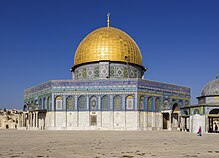Holiest sites in Islam

The holiest sites in Islam are predominantly located in the Arabian Peninsula and the Levant.[2] While the significance of most places typically varies depending on the Islamic sect, there is a consensus across all mainstream branches of the religion that affirms three cities as having the highest degree of holiness, in descending order: Mecca, Medina, and Jerusalem. Mecca's Al-Masjid al-Haram (including the Kaaba), Al-Masjid an-Nabawi in Medina and Al-Masjid al-Aqsa in Jerusalem are all revered by Muslims as sites of great importance.[1][3][4][5][6]
Within the Levant, both the Umayyad Mosque in the city of Damascus and the Ibrahimi Mosque in the city of Hebron have held interchangeable significance as the fourth-holiest Islamic sites.[7]
After the consensus on the first three sites as well as further sites associated with the family of Muhammad, there is a divergence between Sunni Muslims and Shia Muslims on the designation of additional holy sites. For Sunnis, sites associated with the Rashidun, other Companions of Muhammad, and Biblical prophets hold a high level of significance (see holiest sites in Sunni Islam). For Shias, sites associated with the Imamah hold a high level of significance (see holiest sites in Shia Islam).[8] As part of the Hajj, the majority of Muslims also visit the sites of Mina, Mount Arafat, and Muzdalifah, in addition to the Kaaba.[9]
Hejaz[edit]
Hejaz is the region in the Arabian Peninsula where Mecca and Medina are located. It is where the Islamic prophet Muhammad was born and raised.[10]
The two holy cities of Islam, Mecca and Medina, are traditionally known as the Ḥaramayn, which is the dual form of ḥaram, thus meaning "The Two Sanctuaries".[11] They should not be confused with Jerusalem and Hebron, which were also called Haramain during the Mamluk period.[11] Another appellation of the Two Noble Sanctuaries is Ḥaramayn Ṭayyibayn.
Mecca[edit]

Mecca is considered the holiest city in Islam, as it is home to Islam's holiest site Kaaba in Al-Masjid Al-Ḥaram (The Sacred Mosque).[1][4] Only Muslims are allowed to enter this place.[12]
The area of Mecca, which includes Mount Arafah,[13] Mina and Muzdalifah, is important for the Ḥajj ('Pilgrimage'). As one of the Five Pillars of Islam,[14] every adult Muslim who is capable must perform the Hajj at least once in their lifetime.[15] Hajj is one of the largest annual Muslim gatherings in the world, second only to pilgrimages to the mosques of Husayn ibn Ali and his half-brother Abbas in Karbala, Iraq, with attendance reaching three million in 2012.[16]
Medina[edit]

Al-Masjid an-Nabawi is located in Medina, making the city the second-holiest site in Islam, after Mecca. Medina is the final place-of-residence of Muhammad, and where his qabr (grave) is located.[1] In addition to the Prophet's Mosque, the city has the mosques of Qubāʾ[17] and Al-Qiblatayn ("The Two Qiblahs").[18]
Levant[edit]
Ash-Shaam[19] or the Levant[20] is a historical region that includes the cities of Jerusalem and Damascus.[19][21][22]
Jerusalem[edit]
The Al-Aqsa Mosque compound (Al-Masjid Al-Aqsa) in Jerusalem is the third holiest site in Islam. The compound is held in esteem by the entire Muslim community, due to its history as a place of worship by many prophets such as Ibrahim (Abraham),[4] Dawud (David), Sulaiman (Solomon), Ilyas (Elijah) and Isa (Jesus). The mosque has the capacity to accommodate in the region of 400,000 worshippers.[23] According to Islamic tradition, the Temple Mount served as the first qiblah (direction of prayer) for Muhammad and his Ummah, before the Kaaba in Mecca. Muslims believe that Muhammad was taken from Masjid al-Haram in Mecca, to visit Masjid al-Aqsa, where he led the prayer among the prophets, and was then taken to the heavens from the Foundation Stone[citation needed] (today part of the Dome of the Rock) in a single night in the year 620.[24]
The Qur'an mentions the Al-Aqsa Mosque only once in verse 1 of chapter no. 17[25] (Surah Al-Isra'),[26] as "the Farthest Mosque". Islamic scholars generally agree that this description refers to the Al-Aqsa Mosque, although Jerusalem is not mentioned in the Qur'an by name.[27]
Damascus[edit]
The Umayyad Mosque in Damascus is often considered the fourth holiest site in Islam.[7][28] The head of John the Baptist, revered in Islam as the prophet Yahya, is believed to be in a shrine inside the mosque, which also houses one of only four authorized original copies of the Quran. The Umayyad Mosque is also the place where Muslims believe the prophet Isa(Jesus) will return at the end of times, atop the "Minaret of Isa" of the mosque, during the time of a Fajr prayer. It is believed that prayers in the Umayyad mosque are considered to be equal to those offered in Jerusalem.[29]
The mosque also holds special importance to Shia Muslims since it contains shrines commemorating Husayn ibn Ali and the Ahl al-Bayt, made to walk there from Iraq, after the Battle of Karbala.[30] Furthermore, it was the place where they were imprisoned for 60 days.[31]
Hebron[edit]
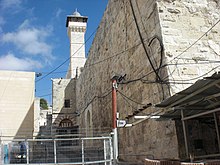
In Islamic belief, Hebron was where the Ibrahim (Abraham) settled. Within the city lies the Sanctuary of Abraham, the traditional burial site of the biblical Patriarchs and Matriarchs, and the Ibrahimi Mosque, built on top of the tomb to honor Abraham, is also often considered to be the fourth holiest in Islam.[32][33][34] Muslims believe that Muhammad visited Hebron on his nocturnal journey from Mecca to Jerusalem to stop by the tomb and pay his respects.[32] In the mosque in a small niche there is a left footprint, believed to be from Muhammad.[35][36]
Sinai Peninsula[edit]
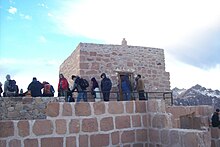
The Sinai Peninsula is associated with the prophets Harun (Aaron) and Musa (Moses).[37] In particular, numerous references to Mount Sinai exist in the Quran,[38][39] where it is called Ṭūr Saināʾ,[40] Ṭūr Sīnīn,[41] and aṭ-Ṭūr[42][43] and al-Jabal (both meaning "the Mount").[44] As for the adjacent Wād Ṭuwā (Valley of Tuwa), it is considered as being muqaddas[45][46] (sacred),[47][48] and a part of it is called Al-Buqʿah Al-Mubārakah ("The Blessed Place").[43]
Sunni Islam[edit]
In Sunni Islam, all sites which have been mentioned in the Hadith are holy to Sunni Muslims. The Kaaba is the holiest site, followed by the al-Masjid an-Nabawi (The Prophet's Mosque), al-Aqsa Mosque compound, and other sites mentioned in the Hadith, as well Umayyad Mosque, Ibrahimi Mosque.
Kaaba[edit]
The Kaaba or Masjid al-Haram in Mecca, is the most sacred holy place of Islam and a Qibla of the Muslims, contains al-Bayt ul-Ma'mur spiritually above the Kaaba, contains the Maqam Ibrahim, Hateem, and the Al-Hajar-ul-Aswad which belonged in Jannah to Adam and Eve (Adam and Hawa). According to the Islamic tradition it was first built by the first prophet Adam, after Noah's Flood the flood of the prophet Nūḥ (Noah), it was then rebuilt by Abraham (ʾIbrāhīm) and his son Ishmael (Ismāʿīl), it has been rebuilt several times.
Masjid an-Nabawi[edit]
Masjid an-Nabawi or The Prophet's Mosque in Medina, contains the grave of Muhammad. The two companions Abu Bakr and Umar are also buried with Muhammad, the grave of Uthman in located in al-Baqi' cemetery located to the southeast of the Prophet's Mosque, while the grave of Ali is in Najaf. The grave of al-Hasan is also in al-Baqi', while al-Husayn is buried in Karbala.
Masjid al-Aqsa[edit]
Jerusalem's Temple Mount, called Masjid al-Aqṣā, was the first qibla of the Muslims before the Kaaba. According to tradition, Muhammad on the occasion of Isra' and Mi'raj led all the prophets and angels at the site, the site of the mosque built by Sulaymān, son of Dāwūd and king of the Israelites.
Others[edit]
- The Damascus Mosque is also considered the sacred mosque for the Muslims, and it is believed that Jesus (ʿĪsā ibn Maryam) will return in this mosque.
- The Ibrahimi Mosque in Palestine, contains the burial of Ibrahim and a few members of his family.
- The city Bukhara in Uzbekistan (which is associated with Imam Al-Bukhari) is considered as a holy city.[49][50]
- The town of Chinguetti in Mauritania, whose libraries contain many ancient manuscripts
Shia Islam[edit]
After the four mosques accepted by all Muslims as holy sites, the Shi'ah consider Imam Ali Masjid in Najaf as the holiest site of only Shia Muslims, followed by Imam Husayn Shrine in Karbala.
Imam Ali Mosque[edit]
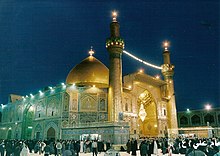
Imam Ali Mosque in Najaf, Iraq is the holiest site for Shia Muslims as the first Shia Imam Ali was buried here. The site is visited annually by at least 8 million pilgrims on average, which is estimated to increase to 20 million in years to come.
Imam Husayn Shrine[edit]
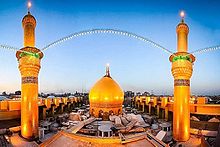
Imam Husayn Shrine in Karbala, Iraq is the second most holiest site for Shia Muslims. It contains the tomb of Husayn ibn Ali. The mosque stands on the site of the grave of Husayn ibn Ali, where he was martyred during the Battle of Karbala in 680.[51][52] Up to 20 million pilgrims visit the city for the anniversary of Hussein ibn Ali's death.[53] There are many Shia traditions which narrate the status of Karbala.
Fatima Masumeh Shrine[edit]

The city of Qom in Iran contains the tomb of Fātimah bint Mūsā, sister of the eighth Twelver Shi'ite Imam, Ali al-Rida. The tomb has been considered to be the third holiest shrine in Twelver Shia Islam.[8] The shrine has attracted to itself dozens of seminaries and religious schools.
Sufi Islam[edit]
Mazar Ghous[edit]

Mazar Ghous in Baghdad, Iraq is the one of the holiest site in Sufi Islam. It is dedicated to the founder of Qadiryya Sufi order, Abdul Qadir Gilani. The complex was built near the Bab al-Sheikh (ash-Sheikh Gate) in al-Rusafa.[54][55][56]
Tomb of Shah Rukn-e-Alam[edit]
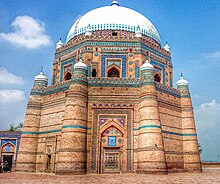
The Tomb of Shah Rukn-e-Alam in Multan is considered the third most holiest site in Sufi Islam. It is the mausoleum of Multan's Sufi saint Sheikh Rukn-ud-Din Abul Fateh. It is one of the most impressive shrines in the world.[57] The shrine attracts over 100,000 pilgrims to the annual Urs festival that commemorates his death.
See also[edit]
References[edit]
- ^ a b c d Trofimov, Yaroslav (2008), The Siege of Mecca: The 1979 Uprising at Islam's Holiest Shrine, New York, p. 79, ISBN 978-0-307-47290-8
{{citation}}: CS1 maint: location missing publisher (link) - ^ "اهمية المقدسات الاسلامية", almrsal.com
- ^ Quran 48:22–29
- ^ a b c Michigan Consortium for Medieval and Early Modern Studies (1986). Goss, V. P.; Bornstein, C. V. (eds.). The Meeting of Two Dads: Cultural Exchange Between East and West During the Period of the Crusades. Vol. 21. Medieval Institute Publications, Western Michigan University. p. 208. ISBN 0918720583.
- ^ Quran 9:25–129
- ^ Quran 33:09–73
- ^ a b Dumper, Michael (2007). Cities of the Middle East and North Africa: A Historical Encyclopedia. ABC-CLIO. ISBN 978-1-57607-919-5.
- ^ a b {{cite web |last=Escobar |first=Pepe |date=May 24, 2002 |title=Knocking on heaven's door |url=http://www.atimes.com/c-asia/DE24Ag04.html%7Curl-status=unfit |archive-url=https://web.archive.org/web/20020603155002/http://atimes.com/c-asia/DE24Ag04.html%7Carchive-date=June 3, 2002 |access-date=2006-11-12 |location=Central Asia / Russia |publisher=Asia Times Online |quote=according to a famous hadith (saying)... ‘our sixth imam, Imam Sadeg, says that we have five definitive holy places that we respect very much. The third belongs to our first imam of Shia, Ali, which is in Najaf.'}
- ^ Geomatika Advanced Solutions (6 June 2016). Atlas of MAKKAH, Dr. Osama bin Fadl Al-Bahar: Makkah City. Bukupedia. pp. 104–. GGKEY:YLPLD6B31C2.
- ^ Hopkins, Daniel J.; 편집부 (2001). Merriam-Webster's Geographical Dictionary. Merriam-Webster. p. 479. ISBN 0-87779-546-0. Retrieved 2013-03-17.
- ^ a b Haramayn at MadainProject.com. Accessed 19 Nov. 2022.
- ^ Tucker & Roberts 2008, p. 673.
- ^ Quran 2:124–217
- ^ Musharraf 2012, p. 195.
- ^ Peters 1994, p. 22.
- ^ Blatt 2015, p. 27.
- ^ Description of the new mosque and architectural documents at archnet.org Archived January 8, 2009, at the Wayback Machine
- ^ "CRCC: Center For Muslim-Jewish Engagement: Resources: Religious Texts". Usc.edu. Archived from the original on 2011-01-07. Retrieved 2011-01-12.
- ^ a b Mustafa Abu Sway. "The Holy Land, Jerusalem and Al-Aqsa Mosque in the Qur'an, Sunnah and other Islamic Literary Source" (PDF). Central Conference of American Rabbis. Archived from the original (PDF) on 2011-07-28.
- ^ Shaam
- ^ Bosworth, C. E. (1997). "AL-SHĀM". Encyclopaedia of Islam. Vol. 9. p. 261.
- ^ Salibi, K. S. (2003). A House of Many Mansions: The History of Lebanon Reconsidered. I. B. Tauris. pp. 61–62. ISBN 978-1-86064-912-7.
To the Arabs, this same territory, which the Romans considered Arabian, formed part of what they called Bilad al-Sham, which was their own name for Syria. From the classical perspective however Syria, including Palestine, formed no more than the western fringes of what was reckoned to be Arabia between the first line of cities and the coast. Since there is no clear dividing line between what are called today the Syrian and Arabian deserts, which actually form one stretch of arid tableland, the classical concept of what actually constituted Syria had more to its credit geographically than the vaguer Arab concept of Syria as Bilad al-Sham. Under the Romans, there was actually a province of Syria, with its capital at Antioch, which carried the name of the territory. Otherwise, down the centuries, Syria like Arabia and Mesopotamia was no more than a geographic expression. In Islamic times, the Arab geographers used the name arabicized as Suriyah, to denote one special region of Bilad al-Sham, which was the middle section of the valley of the Orontes river, in the vicinity of the towns of Homs and Hama. They also noted that it was an old name for the whole of Bilad al-Sham which had gone out of use. As a geographic expression, however, the name Syria survived in its original classical sense in Byzantine and Western European usage, and also in the Syriac literature of some of the Eastern Christian churches, from which it occasionally found its way into Christian Arabic usage. It was only in the nineteenth century that the use of the name was revived in its modern Arabic form, frequently as Suriyya rather than the older Suriyah, to denote the whole of Bilad al-Sham: first of all in the Christian Arabic literature of the period, and under the influence of Western Europe. By the end of that century it had already replaced the name of Bilad al-Sham even in Muslim Arabic usage.
- ^ National Geographic Society (U.S.); de Blij, H.J.; Downs, R.; John Wiley & Sons (2007). Wiley/National Geographic College Atlas of the World. Wiley. p. 49. ISBN 978-0-471-74117-6. Retrieved 2022-06-15.
Al 'Aqsa is the second oldest mosque in Islam after the Kaaba in Mecca and is third in holiness after the mosques in Mecca and Medina. It holds up to 400,000 worshippers at one time.
- ^ The Encyclopaedia of Islam. Vol. 7 (New ed. 2006 ed.). Brill. 2006. pp. 97–105.
- ^ "Surah Al-Isra - 1". quran.com. Retrieved 16 August 2021.
- ^ Quran 17:1–7
- ^ Sway, Mustafa Abu (2011). "The Holy Land, Jerusalem and Al-Aqsa Mosque in the Qur'an, Sunnah and other Islamic Literary Sources" (PDF). Central Conference of American Rabbis. 28. Retrieved 18 October 2023.
- ^ Birke, Sarah. "Damascus: What's Left | Sarah Birke". The New York Review of Books. Retrieved 2022-05-19.
- ^ Janet L. Abu-Lughod (2007). "Damascus". In Dumper, Michael R. T.; Stanley, Bruce E. (eds.). Cities of the Middle East and North Africa: A Historical Encyclopedia. ABC-CLIO. pp. 119–126. ISBN 978-1-5760-7919-5.
- ^ Qummi, Shaykh Abbas (2005). Nafasul Mahmoom. Qum: Ansariyan Publications. p. 362.
- ^ Nafasul Mahmoom. p. 368.
- ^ a b Vitullo, Anita (2003). "People Tied to Place: Strengthening Cultural Identity in Hebron's Old City". Journal of Palestine Studies. 33: 68–83. doi:10.1525/jps.2003.33.1.68. quote: From earliest Islam, the sanctuaries of Hebron and Jerusalem [al-Haram al-Ibrahimi and al-Haram al-Sharif] were holy places outranked only by Mecca and Medina; the Ibrahimi Mosque was originally regarded by some Muslims as Islam's fourth holiest site. Muslims believe that the Hebron sanctuary was visited by the Prophet Muhammad on his mystical nocturnal journey from Mecca to Jerusalem.
- ^ Aksan & Goffman 2007, p. 97: 'Suleyman considered himself the ruler of the four holy cities of Islam, and, along with Mecca and Medina, included Hebron and Jerusalem in his rather lengthy list of official titles.'
- ^ Honigmann 1993, p. 886
- ^ Janet L. Abu-Lughod (2007). "Damascus". In Dumper, Michael R. T.; Stanley, Bruce E. (eds.). Cities of the Middle East and North Africa: A Historical Encyclopedia. ABC-CLIO. pp. 166–167. ISBN 978-1-5760-7919-5.
- ^ "Hebron: The city of Abraham, the Beloved". 2005-04-26.
- ^ Jewish Encyclopedia
- ^ Sharīf, J.; Herklots, G. A. (1832). Qanoon-e-Islam: Or, The Customs of the Moosulmans of India; Comprising a Full and Exact Account of Their Various Rites and Ceremonies, from the Moment of Birth Till the Hour of Death. Parbury, Allen, and Company.
koh-e-toor.
- ^ Abbas, K. A. (1984). The World is My Village: A Novel with an Index. Ajanta Publications.
- ^ Quran 23:20 (Translated by Yusuf Ali)
- ^ Quran 95:2 (Translated by Yusuf Ali)
- ^ Quran 2:63–93
- ^ a b Quran 28:3–86
- ^ Quran 7:103–156
- ^ Quran 20:9–99
- ^ Quran 79:15–25
- ^ Ibn Kathir (2013-01-01). Dr Mohammad Hilmi Al-Ahmad (ed.). Stories of the Prophets: [قصص الأنبياء [انكليزي. Dar Al Kotob Al Ilmiyah (Arabic: دَار الْـكُـتُـب الْـعِـلْـمِـيَّـة). ISBN 978-2745151360.
- ^ Elhadary, Osman (2016-02-08). "11, 15". Moses in the Holy Scriptures of Judaism, Christianity and Islam: A Call for Peace. BookBaby. ISBN 978-1483563039.
- ^ Jones, Kevin. "Slavs and Tatars: Language arts." ArtAsiaPacific 91 (2014): 141.
- ^ Sultanova, Razia. From Shamanism to Sufism: Women, Islam and Culture in Central Asia. Vol. 3. IB Tauris, 2011.
- ^ Shimoni & Levine, 1974, p. 160.
- ^ Aghaie, 2004, pp. 10-11.
- ^ "Interactive Maps: Sunni & Shia: The Worlds of Islam". PBS. Retrieved June 9, 2007.
- ^ Al-Ghunya li-talibi tariq al-haqq wa al-din (Sufficient provision for seekers of the path of truth and religion), parts one and two in Arabic, Al-Qadir, Abd and Al-Gilani. Dar Al-Hurya, Baghdad, Iraq, (1987).
- ^ Al-Ghunya li-talibi tariq al-haqq wa al-din (Sufficient provision for seekers of the path of truth and religion) with introduction by Al-Kilani, Majid Irsan. Al-Kilani, Majid, al-Tariqat, 'Ursan, and al-Qadiriyah, Nash'at
- ^ "The Qadirya Mausoleum" (PDF).
- ^ Asghar, Muhammad (2016). The Sacred and the Secular: Aesthetics in Domestic Spaces of Pakistan/Punjab. LIT Verlag Münster. ISBN 9783643908360.
Bibliography[edit]
- Aksan, Virginia H.; Goffman, Daniel (2007). The early modern Ottomans: remapping the Empire. Cambridge University Press. ISBN 978-0-521-81764-6. Retrieved 13 October 2010.
- Peters, Francis (1994). The Hajj: The Muslim Pilgrimage to Mecca and the Holy Places. Princeton, New Jersey: Princeton University Press. ISBN 9780691026190.
- Musharraf, Hussain (2012). The Five Pillars of Islam: Laying the Foundations of Divine Love and Service to Humanity. Leicestershire, UK: Kube Publishing. ISBN 9781847740236.
- Blatt, Amy (2015). Health, Science, and Place: A New Model. Cham, Switzerland: Springer. doi:10.1007/978-3-319-12003-4. ISBN 978-3319120027. S2CID 183074116.
- Tucker, Spencer; Roberts, Priscilla (2008). The encyclopedia of the Arab-Israeli conflict : a political, social, and military history. Santa Barbara, California: ABC-CLIO. ISBN 978-1851098415.
- Honigmann, Ernst (1993) [1927]. "Hebron". In Houtsma, M. T. (ed.). E.J. Brill's first encyclopedia of Islam, 1913–1936. Vol. IV. BRILL. pp. 886–888. ISBN 978-90-04-09790-2.

